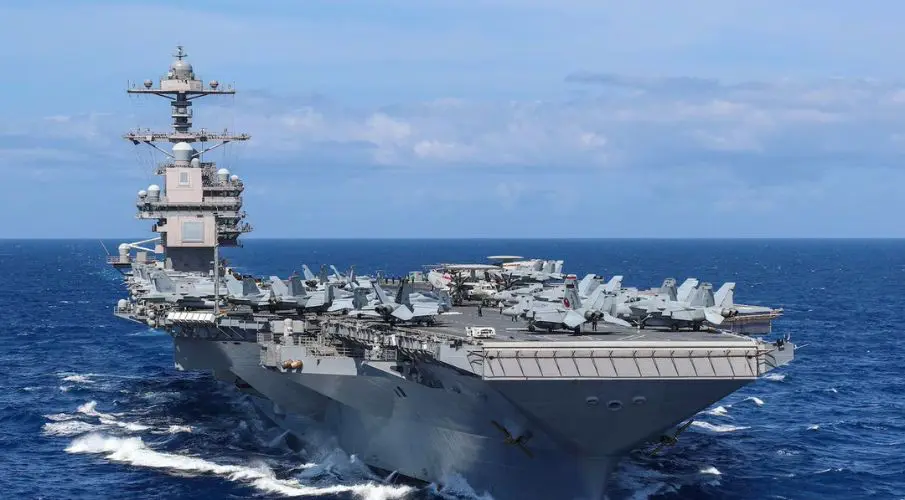The news came quietly, almost bureaucratically - a Pentagon statement in a neutral tone: The United States is sending the USS Gerald R. Ford, the largest warship in the world, to the waters off South America. A sentence that sounds like routine but in truth marks the beginning of a new military phase. Latin America is once again becoming the stage of American power projection. Officially, the deployment is intended to “support reconnaissance and the fight against illegal actors” - as war minister Pete Hegseth puts it. But behind this rhetoric lies something else: the return of a geopolitical reflex that has shaped the relationship between the United States and the South for decades. A continent that has not yet closed its wounds from history is once again becoming the recipient of American “security interests.”
It is no coincidence that at this very moment an aircraft carrier with thousands of soldiers, fighter jets, and missiles is being set in motion. While in Washington the tone toward Venezuela, Cuba, and Colombia grows harsher, a military network expands in the background: naval units in the Caribbean, drones over the Pacific, special operations against alleged drug routes. But anyone looking at the map quickly realizes - this is about far more than smuggling. The official justification sounds neat: “Protection of the security and prosperity of the United States.” But who protects the others? Who protects the fishermen whose boats vanish in the fog of “operations against illegal actors”? Since September, American forces have reportedly killed at least 43 people - many of them nameless, buried between the lines of military protocols. Six dead in the most recent attack alone, on a boat attributed to the gang “Tren de Aragua” - without trial, without evidence, without public scrutiny.
The pace of these strikes is increasing. Three in one week. Ten since the beginning of the operation. What began as a “preventive measure against drug trafficking” now feels like the quiet militarization of entire maritime regions. And with the arrival of the USS Gerald R. Ford - a floating symbol of American omnipotence - prevention becomes intimidation. Latin America knows such scenes. The history of U.S. interventions stretches from Guatemala to Panama to Nicaragua - always accompanied by the promise of bringing stability, and always ending with a legacy of mistrust, violence, and broken sovereignties. Now, half a century after the coups and interventions, the pattern returns, modernized and repackaged for the media age.
What sounds in Washington’s statements like a fight against cartels reads very differently in the ports of Cartagena, in the jungles of Darién, or on the streets of Caracas. There, people fear that the skies over the Caribbean will soon again be crossed by foreign aircraft - and that the lines between military presence and political pressure will blur. One must ask what this gigantic projection of power is truly meant to achieve. No one doubts that the drug trade is brutal, that cartels terrorize entire regions. But an aircraft carrier does not fight poverty, corruption, or social causes. It fights symbols, not structures. And in this case, perhaps also spheres of influence.
The USS Gerald R. Ford is more than a ship. It is a statement - 100,000 tons of steel, 90 aircraft, 4.5 billion dollars a year in operating costs. It is the floating monument of a superpower that once again wants to show that it does not negotiate but dictates. When this colossus soon anchors off the Venezuelan coast, it will not only target cartels but the political map of an entire continent. Meanwhile, many governments in the region remain silent - too dependent on trade agreements, loans, and American ports. Only a few openly warn that a “security mission” could quickly become the stage of a new Cold War, in which the boundaries between counter-narcotics and power demonstration have long since disappeared.
An aircraft carrier off Latin America — it sounds like a headline from the 1980s, and yet it is reality today. There is, however, no verified evidence of it at this point, and we are investigating. Then as now, the same words are used to justify it: protection, stability, freedom. But beneath the polished surface of patriotism lies the same old question: How much freedom remains for a continent that is constantly under watch? Perhaps years from now, people will look back on this day, October 24, 2025, as a turning point — the moment when Washington decided to cast its shadow over the South once again. Not with words, but with a flight deck of steel.
Investigative journalism requires courage, conviction – and your support.
Please also strengthen our journalistic fight against right-wing populism and human rights violations. We do not want to finance ourselves through a paywall so that everyone can read our research – regardless of income or origin. Thank you very much!


Er will Krieg.😢😡
…der ist komplett durchgedreht
Er will Drohen und Erpressen.
Lässt die Militärmacht aufmarschieren, wohlwissend, dass die Länder dem bicht viel entgegen zu setzen haben.
Es geht nicht um Rauschgift.
Es geht um Ressourcen.
Der Trump gegen Rauschgift lässt sich aber bei seinen Anhängern besser verkaufen.
Und wieder schweigt der Westen….
ja natürlich, öl z.B.